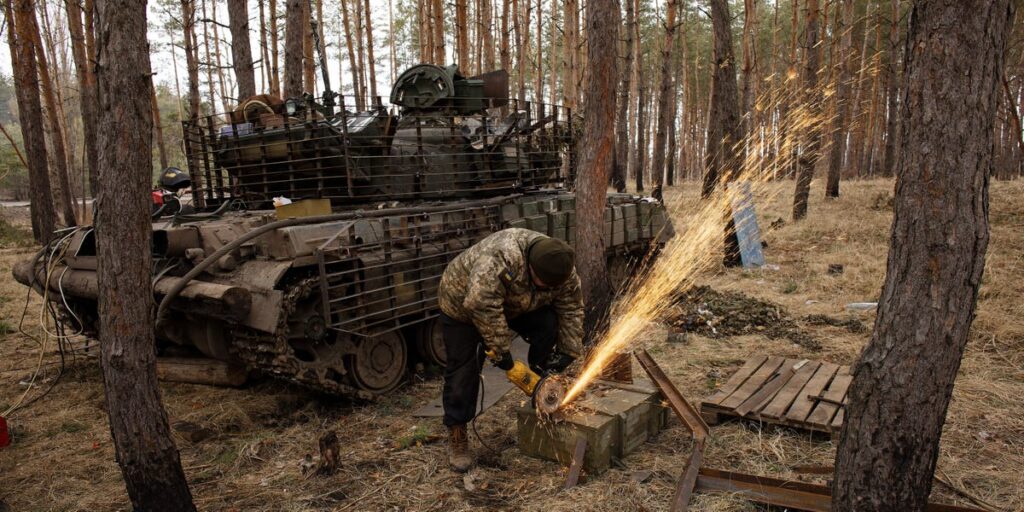The heavily armored M1 Abrams tank is widely regarded as one of the best and toughest tanks in Ukraine today, but even it can’t ride out without cages to shield it from drones.
The overwhelming presence of drones, including ones that fly into military vehicles and explode or burst into flames, has become a defining element of the war in Ukraine, and both sides are working quickly to adapt to this growing threat.
Battle tanks and other armored vehicles, including US-provided Abrams and Bradleys, other Western tanks like the German Leopard, and top Russian tanks like the T-90M, have at times fallen prey to one-way attack drones. In many cases, elite weapons worth millions are being taken out by systems worth only a few hundred dollars.
What started as unusual has become commonplace. Main battle tanks often sport large, welded “cope cages” to stop exploding drones from taking them out. Some have looked crude and ineffective, but more recent models have appeared sturdier, more refined.
The growing consensus is that these cages and defenses like them aren’t going anywhere because unmanned systems like those seen in Ukraine are the future of warfare.
“It’s absolutely here to stay,” Mark Cancian, a retired Marine Corps colonel and a senior advisor at the Center for Strategic and International Studies, said.
“The idea has been around for a little while,” he said, calling attention to the US employing cages around its Strykers in Iraq and Afghanistan to protect against enemy rocket-propelled grenades. And now,” with the ubiquity of drones, it has gained momentum, and I think is now a permanent part of armored vehicles,” he added.
Photos shared online last month showed a US-supplied M1A1 Abrams tank with improvised cages.
Like previously documented examples, the cages look to be built around the sides and top of the turret, giving the tank an exterior defense to protect it from exploding unmanned aerial vehicles, particularly small first-person-view drones.
The recent pictures suggest that even the Abrams, considered the best tank Ukraine’s received from its Western allies, needs some extra help to stop drones and other anti-tank weapons, but that’s not necessarily a shocking development.
Mick Ryan, a retired Australian major general and strategist following trends in warfare, said that “it shouldn’t be surprising that we see a drone cage on an Abrams, just like we see a drone cage on every other tank at this point.” He added that when he saw the pictures, he thought, “Well, of course that would happen.”
The “Ukrainians,” Ryan said, “are smart, they’re adaptive, and they’re coming up with better ways to protect themselves and maintain combat power.” The Ukrainians, notably, aren’t the only ones that are adapting, though. The Russians are as well, fielding things like the so-called “turtle tank.”
Images of Ukrainian and Russian tanks and armored vehicles with cages have been seen more frequently as first-person-view drone attacks have become more prevalent. Some pictures online back in June 2023 showed a Russian MT-LB and a T-72B tank with a large counter-UAV screen. A video from July captured a Ukrainian M109L SPH with extensive anti-drone cage armor.
And as exploding drones continue to threaten just about anything that moves on the battlefield, the world has seen T-64s, additional T-72s, T-80s, T-90s rocking cages, as well as some Western tanks. In some cases, both sides have also employed electronic warfare devices to jam or disrupt incoming drones. That, too, has come to be considered an important part of the counter-drone fight.
Some cages have appeared more sophisticated than others and proven more effective in combat. Early models looked to only cover specific areas of the vehicles — the top, for example, while the sides and rears were exposed. These cages have also been seen in other conflicts, such as Israel’s war in Gaza.
Ukraine’s new Abrams tank cage looks like it could be more purposefully designed to add another layer of protection and potentially increase the survivability of the crew.
It’s unsurprising to see the designs get better, as both sides seek to innovate and keep their vehicles and crews in battle. “It’s been happening throughout the war, they’ve been responding,” Ryan said. “I look at these kind of adaptations, and they’re interim steps as we figure out different ways to counter the drone threat.”
The netting-like cages that Ukraine and Russia are putting on their tanks and armor appear to be a last-ditch effort against anti-tank missiles and artillery as well. Russia, notably, employed cages before the widespread use of drones to stop US-provided Javelin weapons.
But right now, the drones are by far the greatest threat, and the effects on the battlefield in Ukraine are changing the way many militaries are thinking about warfare.
In Iraq and Afghanistan, the US military was able to adapt to the threat of improvised explosive devices that ravaged the underbellies of vehicles. Now, learning from drone usage in Ukraine to improve the coming Abrams and future Bradley replacement is vital.
Cancian explained that because drones, as well as anti-tank weapons, are going to be a growing and enduring presence in war, cages or protective features similar to them are going to become a permanent part of a vehicle’s equipment.
“In the future,” he explained, “you’ll see either tanks will have it already incorporated, or there will be a standard kit you put on.”
Read the full article here


